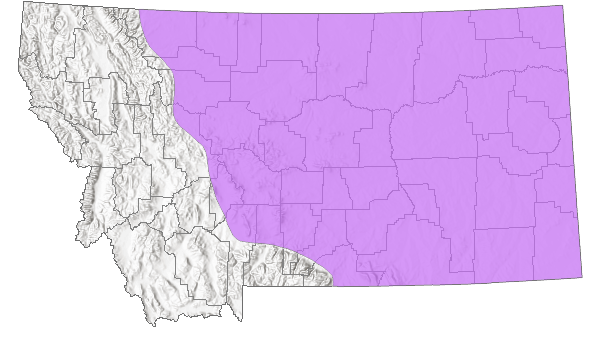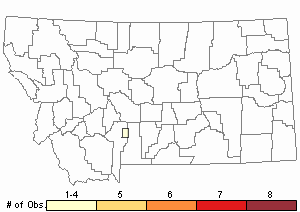View in other NatureServe Network Field Guides
NatureServe
Montana
Utah
Wyoming
Idaho
Wisconsin
British Columbia
South Carolina
Yukon
California
New York
Common Claybank Tiger Beetle - Cicindela limbalis
Other Names:
Green-margined Tiger Beetle
Native Species
Global Rank:
G5
State Rank:
S5
Agency Status
USFWS:
USFS:
BLM:
External Links
General Description
The following comes from Wallis (1961), Kippenhan (1994), Knisley and Schultz (1997), Leonard and Bell (1999), Acorn (2001), and Pearson et al (2015). Body length is 11-16 mm; bright reddish to reddish-green above (rarely dull green or brown green). Margins of head, pronotum, elytra contrasting with bright green or blue. Maculations are distinct, the middle maculation variable but usually horizontal with a middle wave-like acute bend that generally reaches the outer edge of the elytra; shoulder maculation reduced to two dots, the poshumeral dot large; maculations sometimes connected by a marginal band. The underside of abdomen and thorax is metallic greenish-blue, coppery on the lateral portions of the thorax; underside of head and pronotum bright red. Forehead is hairy, labrum short with three teeth, and elytra with granulate surface. Referred to as C. purpurea limbalis in older literature (e.g., Criddle 1907, Shelford 1908).
Phenology
Tiger beetle life cycles fit two general categories based on adult activity periods. “Spring-fall” beetles emerge as adults in late summer and fall, then overwinter in burrows before emerging again in spring when mature and ready to mate and lay eggs. The life cycle may take 1-4 years. “Summer” beetles emerge as adults in early summer, then mate and lay eggs before dying. The life cycle may take 1-2 years, possibly longer depending on latitude and elevation (Kippenhan 1994, Knisley and Schultz 1997, and Leonard and Bell 1999). Adult Cicindela limbalis is a spring-fall species. In the northeastern U.S. from mid-April (possibly as early as February) through June, then late-August to mid-September. In the midwest and west from March to mid-July then September to October, with stragglers in summer (Carter 1989, Kippenhan 1994, Acorn 2001, Larochelle and Larivière 2001, and Pearson et al. 2015). In Montana, adults are present at least from early-May to late June and late July to mid-September (Nate Kohler personal communication).
Diagnostic Characteristics
The following is taken largely from Kippenhan (1994), Acorn (2001), and Pearson et al. (2015). It is most similar to the reddish forms of
Cow Path Tiger Beetle (
C. purpurea) and purplish forms of the
Badlands Tiger Beetle (
C. decemnotata) but neither species has a middle maculation on the elytra that reaches the elytra margin. The
Badlands Tiger Beetle lacks the metallic greenish-blue on the undersides of the abdomen, while the middle maculation of the
Cow Path Tiger Beetle is short and less acutely angled than in the Common Claybank Tiger Beetle. Recent mtDNA and morphological/ecological studies indicate that the Common Claybank Tiger Beetle,
Green Claybank Tiger Beetle (
C. denverensis), and Splendid Tiger Beetle (
C. splendida) may be a single species (Woodcock and Knisley 2009, and Brust, Homer, and Spomer 2012); the latter species is not yet documented from Montana but occurs nearby in northwestern South Dakota (Pearson et al. 2015).
Species Range
Montana Range
Range Descriptions

 Native
Native
Range Comments
Cicindela limbalis is present from eastern British Columbia and southern Northwest Territories to Newfoundland in Canada, and from the prairie regions of Montana, eastern Wyoming and much of Colorado to New England, south to Virginia (Wallis 1961, Knisley and Schultz 1997, Leonard and Bell 1999, Acorn 2001, and Pearson et al. 2015). In Montana, it is present across the state east of the Continental Divide except much of the mountainous west and southwest.
Observations in Montana Natural Heritage Program Database
Number of Observations: 8
(Click on the following maps and charts to see full sized version)
Map Help and Descriptions
Relative Density

Recency



 (Observations spanning multiple months or years are excluded from time charts)
(Observations spanning multiple months or years are excluded from time charts)
Migration
This species is non-migratory but capable of dispersal. Generally not a quick colonizer (Carter 1989). When wings fully developed (macropterous), it is a good flier and fast runner (Larochelle and Larivière 2001).
Habitat
Adult and larval tiger beetle habitat essentially identical, the larvae live in soil burrows (Knisley and Schultz 1997). Across the range Cicindela limbalis is usually found on steep slopes and barren clay banks, sometimes on stone, gravel, or clay paths among scattered pines, along ditches, little-used roads, road cuts, pocket gopher mounds, sand pits, dry gullies, rarely on salt or sand flats, often in moist or wet soil, sometimes near water (especially the larvae), usually where vegetation is sparse. Found up to at least 8500 ft (2590 m) in Wyoming, probably higher in Colorado (Criddle 1907, Vaurie 1950, Wallis 1961, Hooper 1969, Kippenhan 1994, Knisley and Schultz 1997, Leonard and Bell 1999, Acorn 2001, Larochelle and Larivière 2001, and Kritsky and Smith 2005). In Montana, the habitat is poorly described but includes road cuts, two-track roads, along streams, to at least 6050 ft (1844 m) elevation (Nate Kohler personal communication).
Food Habits
Larval and adult tiger beetles are predaceous. In general, both feed considerably on ants (Wallis 1961, and Knisley and Schultz 1997). The diet of adult Cicindela limbalis in the field includes ants; items in captivity includes ants, carabid beetles, other insects, woodborer larvae, mealworms, and earthworms. Larval foods in the field includes spiders, dragonflies, and moths; in captivity lean meat (Larochelle and Larivière 2001).
Ecology
Larval tiger beetles live in burrows and molt through three instars to pupation, which also occurs in the larval burrow. Adults make shallow burrows in soil for overnight protection and deeper burrows for overwintering. Adults are sensitive to heat and light and are most active during sunny conditions. Excessive heat during midday on sunny days drives adults to seek shelter among vegetation or in burrows (Wallis 1961, and Knisley and Schultz 1997).
Cicindela limbalis has a narrow range of ecological tolerance (stenotopic). Adults are diurnal, usually solitary or in pairs, and hide in burrows up to 48 cm deep dug into clay or sand. Overwintering adults are capable of super-cooling to about –8°C through elevated levels of glycerol in the hemolymph (Burns et al. 2020). Predators across its range include ants (able to drag larvae from burrows), probably asilid (robber) flies; larval parasites include bombyliid flies and eulophid wasps (Larochelle and Larivière 2001). Other associated tiger beetle species include
Green Claybank Tiger Beetle (
C. denverensis),
Boreal Long-lipped Tiger Beetle (
C. longilabris),
Cow Path Tiger Beetle (
C. purpurea),
Bronzed Tiger Beetle (
C. repanda), and
C. splendida (Criddle 1907, Kippenhan 1994, Larochelle and Larivière 2001, and Brust, Hoback, and Spomer 2012).
Reproductive Characteristics
Life cycle of Cicindela limbalis is mostly 2-3 years (Knisley and Schultz 1997, Leonard and Bell 1999, Acorn 2001, and Pearson et al. 2015). Mating is from April to July. Copulation lasts about 2-3 minutes. Adult females oviposit during the day near the surface (7-9 mm) or by digging, to depths of 20-60 mm, in May and June. Larval burrows are 5.0-20.0 cm deep, excavated in steep clayey slopes near water (< 2.0 m) where oviposition also occurs. The burrows are a chimney-like structure, about 6 mm tall at the entrance, and perpendicular to the soil surface with the burrow curving almost horizontally by the end. Fresh adults (tenerals) emerge in August then overwinter and reach sexual maturity in June the following spring. Larvae overwinter as second or third instars. Adult life span is 9-11 months. Interspecific copulations reported with C. sexgutta and C. splendida (Shelford 1908, Larochelle and Larivière 2001, and Brust, Knisley, et al. 2012). No information for Montana.
Management
Not considered rare or in need of special conservation management (Knisley et al. 2014). C. limbalis benefits in particular from anthropogenic creation and maintenance of clay roads, paths, and powerline corridors, although vehicle/bicycle use of roads and paths could negatively impact some local populations. Exotic grasses, such as cheatgrass, could become a problem at local scales where they invade moist and open disturbed habitats. Larval burrows could be impacted by trampling through livestock overgrazing or concentrations near water sources, but grazing at appropriate times and stocking levels could also be beneficial by keeping vegetation cover more open (Knisley 2011).
Stewardship Responsibility
References
- Literature Cited AboveLegend:
 View Online Publication
View Online Publication Acorn, J. 2001. Tiger beetles of Alberta: killers on the clay, stalkers on the sand. The University of Alberta Press, Edmonton, Alberta. 120 p.
Acorn, J. 2001. Tiger beetles of Alberta: killers on the clay, stalkers on the sand. The University of Alberta Press, Edmonton, Alberta. 120 p. Brust, M.L., C.B. Knisley, S.M. Spomer, and K. Miwa. 2012b. Observations of oviposition behavior among North American tiger beetle (Coleoptera: Carabidae: Cicindelinae) species and notes on mass rearing. The Coleopterists Bulletin 66(4):309-314.
Brust, M.L., C.B. Knisley, S.M. Spomer, and K. Miwa. 2012b. Observations of oviposition behavior among North American tiger beetle (Coleoptera: Carabidae: Cicindelinae) species and notes on mass rearing. The Coleopterists Bulletin 66(4):309-314. Brust, M.L., W.W. Hoback, and S.M. Spomer. 2012a. Splendid hybrids: the effects of a tiger beetle hybrid zone on apparent species diversity. Psyche 2012:1-10. doi:10.1155/2012/398180
Brust, M.L., W.W. Hoback, and S.M. Spomer. 2012a. Splendid hybrids: the effects of a tiger beetle hybrid zone on apparent species diversity. Psyche 2012:1-10. doi:10.1155/2012/398180 Burns, M., D. Herrera, T.J. Muir, and T.R. Brosius. 2020. Depressed supercooling point and increased glycerol concentration in overwintering adult tiger beetles (Cicindelida). CryoLetters 41(4):216-222.
Burns, M., D. Herrera, T.J. Muir, and T.R. Brosius. 2020. Depressed supercooling point and increased glycerol concentration in overwintering adult tiger beetles (Cicindelida). CryoLetters 41(4):216-222. Carter, M. R. 1989. The biology and ecology of the tiger beetles (Coleoptera: Cicindelidae) of Nebraska. Transactions of the Nebraska Academy of Sciences XVII: 1-18.
Carter, M. R. 1989. The biology and ecology of the tiger beetles (Coleoptera: Cicindelidae) of Nebraska. Transactions of the Nebraska Academy of Sciences XVII: 1-18. Criddle, N. 1907. Habits of some Manitoba 'tiger beetles' (Cicindela). Canadian Entomologist 39:105-114.
Criddle, N. 1907. Habits of some Manitoba 'tiger beetles' (Cicindela). Canadian Entomologist 39:105-114. Hooper, R.R. 1969. A review of Saskatchewan tiger beetles. Cicindela 1(4):1-5.
Hooper, R.R. 1969. A review of Saskatchewan tiger beetles. Cicindela 1(4):1-5. Kippenhan, Michael G. 1994. The Tiger Beetles (Coleoptera: Cicindelidae) of Colorado. 1994. Transactions of the American Entomological Society 120(1):1-86.
Kippenhan, Michael G. 1994. The Tiger Beetles (Coleoptera: Cicindelidae) of Colorado. 1994. Transactions of the American Entomological Society 120(1):1-86. Knisley, C.B. 2011. Anthropogenic disturbances and rare tiger beetle habitats: benefits, risks, and implications for conservation. Terrestrial Arthropod Reviews 4:41-61.
Knisley, C.B. 2011. Anthropogenic disturbances and rare tiger beetle habitats: benefits, risks, and implications for conservation. Terrestrial Arthropod Reviews 4:41-61. Knisley, C.B., and T.D. Schultz. 1997. The biology of tiger beetles and a guide to the species of the south Atlantic states. Virginia Museum of Natural History Special Publication Number 5. 210 p.
Knisley, C.B., and T.D. Schultz. 1997. The biology of tiger beetles and a guide to the species of the south Atlantic states. Virginia Museum of Natural History Special Publication Number 5. 210 p. Knisley, C.B., M. Kippenhan, and D. Brzoska. 2014. Conservation status of United States tiger beetles. Terrestrial Arthropod Reviews 7:93-145.
Knisley, C.B., M. Kippenhan, and D. Brzoska. 2014. Conservation status of United States tiger beetles. Terrestrial Arthropod Reviews 7:93-145. Kohler, Nathan S. Excel spreadsheets of tiger beetle observations. 6 August 2022.
Kohler, Nathan S. Excel spreadsheets of tiger beetle observations. 6 August 2022. Kritsky, G. and J. Smith. 2005. Teddy's tigers: the Cicindelidae (Coleoptera) of Theodore Roosevelt National Park, North Dakota. Cicindela 37(1-2):1-16
Kritsky, G. and J. Smith. 2005. Teddy's tigers: the Cicindelidae (Coleoptera) of Theodore Roosevelt National Park, North Dakota. Cicindela 37(1-2):1-16 Larochelle, A and M Lariviere. 2001. Natural history of the tiger beetles of North America north of Mexico. Cicindela. 33:41-162.
Larochelle, A and M Lariviere. 2001. Natural history of the tiger beetles of North America north of Mexico. Cicindela. 33:41-162. Leonard, Jonathan G. and Ross T. Bell, 1999. Northeastern Tiger Beetles: a field guide to tiger beetles of New England and eastern Canada. Boca Raton, FL: CRC Press. 176 p.
Leonard, Jonathan G. and Ross T. Bell, 1999. Northeastern Tiger Beetles: a field guide to tiger beetles of New England and eastern Canada. Boca Raton, FL: CRC Press. 176 p. Pearson, D.L., C.B. Knisley, D.P. Duran, and C.J. Kazilek. 2015. A field guide to the tiger beetles of the United States and Canada, second edition. New York, NY: Oxford University Press. 251 p.
Pearson, D.L., C.B. Knisley, D.P. Duran, and C.J. Kazilek. 2015. A field guide to the tiger beetles of the United States and Canada, second edition. New York, NY: Oxford University Press. 251 p. Shelford, V.E. 1908. Life-histories and larval habits of the tiger beetles (Cicindelidae). The Journal of the Linnean Society 30:157-184.
Shelford, V.E. 1908. Life-histories and larval habits of the tiger beetles (Cicindelidae). The Journal of the Linnean Society 30:157-184. Vaurie, P. 1950. Notes on the habitats of some North American tiger beetles. Journal of the New York Entomological Society 58(3):143-153.
Vaurie, P. 1950. Notes on the habitats of some North American tiger beetles. Journal of the New York Entomological Society 58(3):143-153. Wallis, J.B. 1961. The Cicindelidae of Canada. Toronto, Ontario, Canada: University of Toronto Press. 74 p.
Wallis, J.B. 1961. The Cicindelidae of Canada. Toronto, Ontario, Canada: University of Toronto Press. 74 p. Woodcock, R.M. and C.B. Knisley. 2009. Genetic analysis of an unusual population of the problematic tiger beetle group, Cicindella spendida/C. limbalis, from Virginia, U.S.A. (Coleoptera: Cicindellidae) using mtDNA. Entomological News 120(4):341-348.
Woodcock, R.M. and C.B. Knisley. 2009. Genetic analysis of an unusual population of the problematic tiger beetle group, Cicindella spendida/C. limbalis, from Virginia, U.S.A. (Coleoptera: Cicindellidae) using mtDNA. Entomological News 120(4):341-348.
- Additional ReferencesLegend:
 View Online Publication
View Online Publication
Do you know of a citation we're missing? Bousquet, Yves. 2012. Catalogue of Geadephaga (Coleoptera; Adephaga) of America north of Mexico. ZooKeys. 245:1-1722.
Bousquet, Yves. 2012. Catalogue of Geadephaga (Coleoptera; Adephaga) of America north of Mexico. ZooKeys. 245:1-1722. Pearson, D.L., C.B. Knisley, and C.J. Kazilek. 2006. A field guide to the tiger beetles of the United States and Canada: identification, natural history, and distribution of the Cicindelidae. Oxford University Press, New York, New York. 227 pp.
Pearson, D.L., C.B. Knisley, and C.J. Kazilek. 2006. A field guide to the tiger beetles of the United States and Canada: identification, natural history, and distribution of the Cicindelidae. Oxford University Press, New York, New York. 227 pp.
- Web Search Engines for Articles on "Common Claybank Tiger Beetle"
- Additional Sources of Information Related to "Insects"





